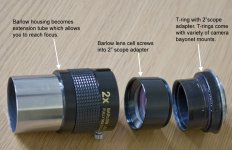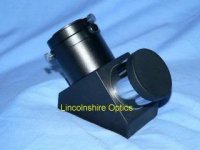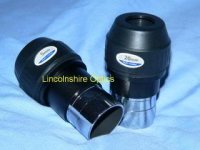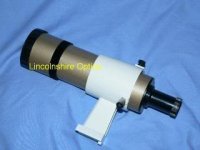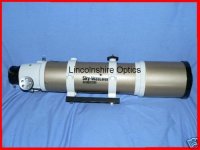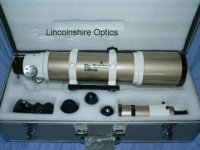Musoman
PETE - Nikon/Sony Shooter

Hi there
I've decided to jump on the scope bandwagon, mainly due to frustration from lack of FL reach.
I currently use just 1 DSLR body, the Canon 450D, and my birding lens is the Sigma 150-500. Its still not long enough for me, but going for big reach DSLR lenses , as i guess you all know already, is pretty expensive.
After some reading here, i've been very impressed with the hard work, testing, reviews and general advice and help given out by the gurus in this forum by the likes of Paul and friends.
I have my eye on purchasing an older model ( gold ) Skywatcher 80ED to mount to my 450D. Trouble is, like a lot of people on the bottom rung of the D/scope ladder, i havent a clue what i'm doing.
I love the Focus confirm of my DSLR ( a must for me as my MF is terrible due to poor eyesight ) so i even bought Focus Confirm chip EOS adapters for some of my old M42 mount lenses. The Focus confirm works fine on these old lenses ..well upto about f5.6 anyways. You can actually fool the camera into Focus confirm when using smaller apertures by taping the the correct 3 pins, but i havent done this myself.
Anyways - the 80ED kit i'm looking at has the following included, according to the shop
Skywatcher Evostar 80ED-Pro OTA refractor
No mount with this package
Evostar ED80 Pro tube assembly
80mm ED Fluorite objective
5mm (120x) and 20mm (30x) multicoated eyepieces
2" Star Diagnol
9x50 finderscope
Dual fit 1.25"/2" Crayford focuser (backlash free)
Tube rings with mounting plate
A camera thread is included
Apart from a teleconverter, Is there anything missing that i need ? How does everything mount together? There's so many options that i've read here, that i got confused about it all.
Fit a lens on the camera or no lens ? ( if yes, would my 50mm f1.8 EBC Fujinon M42 mount be any use )
I see T rings are needed ( what are they ? ) but also read in another thread that T rings aren't necessary , but why ?
http://www.scopesnskies.com/prod/as...amera-adaptor/AC696-2inch to camera/DSLR.html
I've seen photos of birds in flight using D/scoping and is this harder than using a regular DSLR/ Lens set up ?
I have a Uni-loc tripod at the moment - System 1700 with a Kood Ball head, but i think id prefer a simple but decent 2 way Pan + Tilt - does that make sense ?
Is there's any other advice / help you might think to give, i'm willing to listen to all, as this is how i managed to get into DSLR togging. If anyone's interested in some pics i have, here's the link. Most taken with 450d + 150-500 , some with previous gear ( pentax K10D + Tamron 70-350 )
Not exceptional, but good enough for me :t:
http://photo-sharing.winsoftmagic.com/1/5bysjpbd.htm
I've decided to jump on the scope bandwagon, mainly due to frustration from lack of FL reach.
I currently use just 1 DSLR body, the Canon 450D, and my birding lens is the Sigma 150-500. Its still not long enough for me, but going for big reach DSLR lenses , as i guess you all know already, is pretty expensive.
After some reading here, i've been very impressed with the hard work, testing, reviews and general advice and help given out by the gurus in this forum by the likes of Paul and friends.
I have my eye on purchasing an older model ( gold ) Skywatcher 80ED to mount to my 450D. Trouble is, like a lot of people on the bottom rung of the D/scope ladder, i havent a clue what i'm doing.
I love the Focus confirm of my DSLR ( a must for me as my MF is terrible due to poor eyesight ) so i even bought Focus Confirm chip EOS adapters for some of my old M42 mount lenses. The Focus confirm works fine on these old lenses ..well upto about f5.6 anyways. You can actually fool the camera into Focus confirm when using smaller apertures by taping the the correct 3 pins, but i havent done this myself.
Anyways - the 80ED kit i'm looking at has the following included, according to the shop
Skywatcher Evostar 80ED-Pro OTA refractor
No mount with this package
Evostar ED80 Pro tube assembly
80mm ED Fluorite objective
5mm (120x) and 20mm (30x) multicoated eyepieces
2" Star Diagnol
9x50 finderscope
Dual fit 1.25"/2" Crayford focuser (backlash free)
Tube rings with mounting plate
A camera thread is included
Apart from a teleconverter, Is there anything missing that i need ? How does everything mount together? There's so many options that i've read here, that i got confused about it all.
Fit a lens on the camera or no lens ? ( if yes, would my 50mm f1.8 EBC Fujinon M42 mount be any use )
I see T rings are needed ( what are they ? ) but also read in another thread that T rings aren't necessary , but why ?
http://www.scopesnskies.com/prod/as...amera-adaptor/AC696-2inch to camera/DSLR.html
I've seen photos of birds in flight using D/scoping and is this harder than using a regular DSLR/ Lens set up ?
I have a Uni-loc tripod at the moment - System 1700 with a Kood Ball head, but i think id prefer a simple but decent 2 way Pan + Tilt - does that make sense ?
Is there's any other advice / help you might think to give, i'm willing to listen to all, as this is how i managed to get into DSLR togging. If anyone's interested in some pics i have, here's the link. Most taken with 450d + 150-500 , some with previous gear ( pentax K10D + Tamron 70-350 )
Not exceptional, but good enough for me :t:
http://photo-sharing.winsoftmagic.com/1/5bysjpbd.htm




